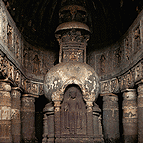Since ancient times, Aurangabad has been of great importance due to its location on the famous "Silk Route" that traversed across Asia to Europe. Textiles and beads were exported to the markets of Greece, Rome and Egypt, along with Buddhist teachings and Indian art forms. Aurangabad's strategic position in the Deccan and topography so impressed Moghul Emperor Tughlaq that he moved his capital down from Delhi, renaming it Daulatabad, giving it the rare distinction of serving as the capital of India. Later it was the seat of Emperor Aurangzeb, as he fought to block the resurgent Maratha power.
Aurangabad's wealth of fascinating historical, cultural, religious and ecological sites include the World Heritage Ellora and Ajanta Caves, Daulatabad fort, Bibi Ka Maqbara, Lonar crater and Ghrishneshwar Jyotirlinga among many others.
The Meadows has an idyllic sylvan setting surrounded by farms and magnificent mountains. Yet it is just 6 kms from the city centre & railway station. The Meadows is the hotel closest to the important tourist sites of Ellora, Daulatabad, Ghrishneshwar and Bibi Ka Maqbara all are within 16 kms of the hotel, as is the airport. The hotel is also near the main industrial area of Waluj, and the shopping district.
Aurangabad is easily accessible from the major cities of India by air, rail or road. It is directly connected by 4 daily flights and trains from Mumbai. It is also well connected to Delhi, Pune, Nasik, Hyderabad, Ahmedabad, Baroda and Surat.
Ellora Caves - 14 km
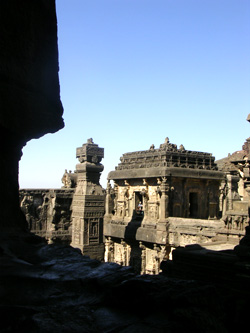
The famous rock cut caves temples of Ellora depict the Hindu, Buddhist and Jain faiths, and were constructed between the 5th and 8th centuries A.D. Of particular interest is the architectural marvel of the monolithic Kailasa temple, carved out in the rocky cliffside from top to bottom. In December, MTDC organises the Ellora festival of music and dance at the Kailasa Temple. The Ellora Caves have been declared a World Heritage Site.
Daulatabad Fort - 7 km
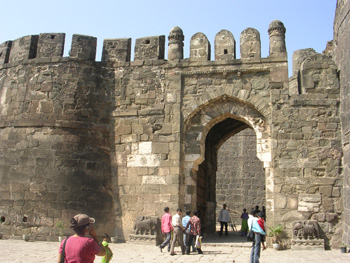
Originally the mountainous Deogiri fortress, it was an old Hindu stronghold, finally captured and plundered by deceit in the 13th century. Made the capital of the Delhi Sultanate a 100 years later by Tughlaq, it was the prime fortress of many succesive dynasties in the Deccan. Daulatabad is famous for it's series of trick defences, secret escape routes, 5 km long wall and artificial scarping. Important monuments within the fort include the Jami Masjid - now the Bharat Mata Mandir, the Chand Minar, Elephant Tank and Chini Mahal or Chinese Palace.
Shahi Hamam
Khufiya Bawdi
Khuldabad - 14 km
At the holy village of Khuldabad or Abode of Eternity is located the tomb of the last great Moghul Emperor Aurangzeb. His simple tomb remains an eloquent testament to the staunch faith and spartan lifestyle of this pious Muslim ruler. As per his instructions, the tomb was built only with the few rupees he had earned by stitching cloth caps.
Aurangzeb's Tomb
Bani Begum Gardens
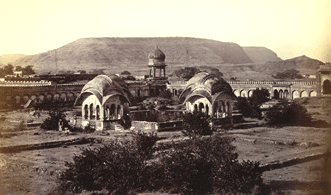
The tomb of Bani Begum, the consort of Aurangzeb's son, lies in a Mughal style garden, enclosed by a handsome wall with arched reesses. An elegant summer pavilion, a mosque and exquisite detailing in the plasterwork and stone jaliwork make it a pleasureable oasis in the Deccan.
Tomb of Malik Ambar
Ajanta Caves - 110 km
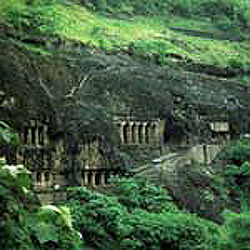
Ajanta's wondrous cave temples are cut into the rocky sides of a dramatic crescent-shaped gorge, at the head of which is a waterfall that drops over the mountain rim in a series of seven steps to a pool far below - the Saptakund. Dating back to the 2nd century B.C, they cover a span of 800 years where under royal patronage of ruling dynasties, professional artists helped Buddhist monks to create magnificent murals narrating the story of Buddha in his cycle of incarnations. Etched and painted in vegetable and mineral dyes, the paintings have a langourous stylised beauty and magical eloquence. The Ajanta Caves are a World Heritage site.
Anwa Temple
The best surviving example of a Chalukya temple in the region, is the beautiful near intact Temple of Anwa, close to the Ajanta Caves. Its hallmark features are its stepped profile, hall with 50 heavily decorated colums, lotus patterned ceiling and exquisite couples and deity sculptures.
Pithalkora
At Pithalkora you can visit possibly the earliest Buddhist caves in this region from the Hinayana and Mahayana periods. Explore the Autramghat Wildlife Sanctuary for its variety of animals and over 230 species of birds. Also visit the 15th century fort of Antur.
Autramghat Sanctuary at Gauthala
Located about 60 km from The Meadows among the hill ranges of the Sahyadris, the bowl shaped Autramghat Wildlife Sanctuary on hilly terrain has diversified vegetation that supports rich fauna and floral diversity. Particularly, it is good as a sloth bear and barking deer habitat along with fox, neelgai, wolves, leopards and rabbits. Over 230 resident and migratory birds can be spotted here including cranes, ibis, spoonbills, storks, quails, partridge and jungle fowl.The sanctuary also contains some scenic waterfalls, the ancient and possibly oldest Buddhist Pithalkora Caves and the 15th century Maratha fort of Antur. We offer naturalist guided tours for birding and sanctuary visits. Excursions include transportation, guide, picnic lunches and first aid boxes in event of emergencies.
Patnadevi Temple
Bibi ka Maqbara - 5 km
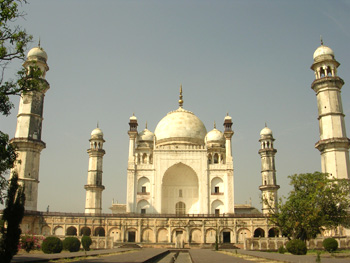
It is the tomb of Begum Rabia Durani, wife of Emperor Aurangzeb. Due to its similar design, it is popularly known as the mini Taj of the Deccan. (Guests at The Meadows can catch a glimpse of the beautiful monument from our gardens.)
Salim Ali Sarovar
Panchakki - 4 km
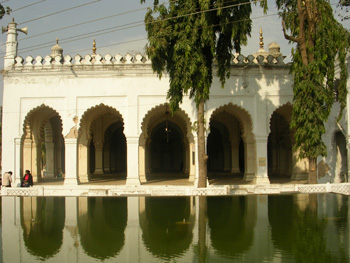
An intriguing water mill, the Panchakki is famous for its underground water channel which traverses more than 8 kms to its source away in the mountains. The channel culminates in a mesmerising 'artificial' waterfall that powers the mill.
Aurangabad Caves - 8 km
Nestled amidst the hills are 12 Buddhist caves probably dating back to the 1 A.D. Of particular interest are the Tantric influences evident in the iconography and architectural designs of the caves.
Chatrapati Shivaji Maharaj Museum
Jayakwadi Birding Reserve
Paithan - 56 km
The ancient city and pilgrim centre of Paithan is situated on the banks of the Godavari river. It was also on the famous "Silk Route" that traversed across the breadth of Asia to Europe. It has remined famous for the the woven Paithani silk sarees inlaid with real silver and gold thread. Visit the weavers workshops for demonstrations and custom orders. In the old city remain one of the unique examples of the traditional 'wada' architecture of the Peshwas. Also worth visiting is the ancient Nag Ghat - riverbank steps - dating back to the Satavahana period. The gardens of the recent Jayakwadi dam are a good spot for birdwatching.
Shirdi
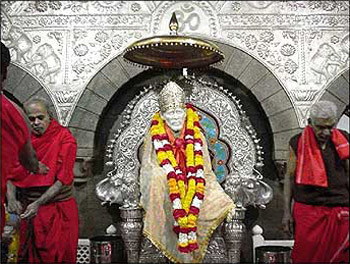
Shirdi is the home of the beautiful temple dedicated to Shri Sai Baba. Built over his Samadhi, it attracts millions of devotees each year, of all religions, castes and creeds. Sai Baba is revered as a saint. He is credited with having transformed the lives of many. Many believe he performed miracles, and continues to do so even after his death in 1918.
Shani Shingnapur
The village is named after the local temple of Shani or planet Saturn, the only such temple in the country. Adding to its distinction is that it is a temple without priests and all rituals are conducted by devotees themselves. Most unique is that under the protection of Saturn, nothing is locked in the entire village - including the bank and prison. Villagers believe that a thief is struck dead if he tries to cross the village borders. Remarkably, the village has no record of theft for over a 100 years.
Kachner
Gurudwara Hazur Sahib - Nanded
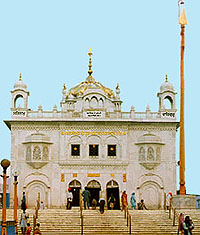
Nanded (pronounced Nander), formerly in Hyderabad State is now a district town in Maharashtra. It is a railway station on the Manmad-Secunderabad section of South Central Railway. One of the five Sikh Takhts is located here and the Sikhs reverently refer to it as Hazur Sahib. Guru Gobind Singh spent the last few days of his earthly life here. Some of the sacred relics of Guru Gobind Singh are also preserved here. These are, a golden dagger, a matchlock gun, an archer with 35 arrows, two bows, a steel shield studded with precious stones and five golden swords. Takhat Sachkhand Sri Hazur Abchalnagar Sahib is the principal shrine at Nanded. It marks the site where the Guru had his camp in 1708 A.D. after the departure of the emperor Bahadur Shah. The tenth Guru held his court and congregation here. It is the site of his own tent where he was convalescing after he was attacked by assasins. It is the place from where the tenth Guru rose to heaven alongwith his horse Dilbag. Besides Gurdwara Sachkhand Sahib, other Gurdwaras at Nanded are Sangat Sahib, Shikar Ghat, Nagina Ghat and Hira Ghat. These too were built in memory of visit of Sri Guru Gobind Singh to this place.
Reservations and inquiries are welcome at Tel. 91-22-66548361/62, 22073014/15, Mobile: 09764441833 Fax. 91-22-22033622
 9764441833
9764441833
Email: sales@themeadowsresort.com , reservations@themeadowsresort.com
Connect with us : ![]()
![]()
Payments options : ![]()
![]()
![]()
![]()
![]()
Website Designed & Website Maintenance by MiracleworX Website Designer In Mumbai
